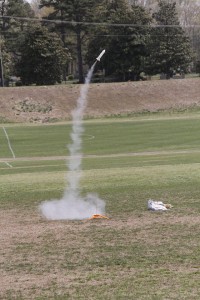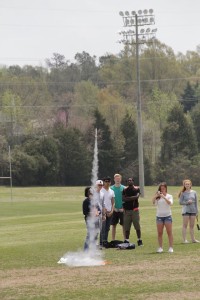Engineering principles take flight with help of 3D printer
 Elon’s 3D printer is a cool device that has spawned 3D renderings of acorns and Despicable Me minions, but it also can have more practical applications in courses on campus. For one, Dr. Sirena Hargrove-Leak of the dual degree engineering program has used the 3D printer with her Challenges in Engineering course as her first-year students designed, printed and eventually launched rockets.
Elon’s 3D printer is a cool device that has spawned 3D renderings of acorns and Despicable Me minions, but it also can have more practical applications in courses on campus. For one, Dr. Sirena Hargrove-Leak of the dual degree engineering program has used the 3D printer with her Challenges in Engineering course as her first-year students designed, printed and eventually launched rockets.
Simulators and 3D printing
Challenges in Engineering is about giving the engineering students an inside look to the field as a whole. They learn about the different facets of the field, learn the creed by which engineers live and apply their theoretical knowledge to practical use to design rockets in the program SolidWorks.
“They have to think about their design and then build it in the simulator tool first,” Dr. Hargrove-Leak said. “They set their own goal for what they wanted their rocket to achieve. Using the simulator, they can predict height. On top of that, I asked them to design or generate device to measure altitude. I asked them to have a device to measure the actual height and compare the results to the simulator. It was two different layers of design.”
The simulation program, OpenRocket, allowed students to input the dimensions of their proposed rocket to see how far it was predicted to fly. Dr. Hargrove-Leak said this was vital in helping her students understand problems that arise when translating a design from paper to production.
“The simulator came in handy because it prompted them to think about things like weight,” Dr. Hargrove-Leak said. “When some students first designed in the simulator, they were disappointed because it only predicted to go 10 feet. It helped them to figure out why these things were happening, which was valuable. Engineers have to think about in a real world context.”
Using the 3D printer to bring the models into the physical world is a relatively new addition to the class. Dr. Hargrove-Leak believes the availability of the printer has made learning computer-aided design move in a whole new, positive direction.
“With the decrease in cost of 3D printing, it’s easy to take designs and turn them into a 3D model,” Dr. Hargrove-Leak. “I was pleasantly surprised how easy it is to 3D print. So many people are afraid of the technology, but it’s really not that bad.”
Challenges of building the rocket
The point of this first-year engineering course is to teach the students how to think as a real engineer has to in order to be successful. Dr. Hargrove-Leak says that this rocket project has taught one major lesson—accounting for potential problems that might not manifest on the design screen.
“Several teams printed their rockets, but when they went to install the motor, it didn’t fit,” Dr. Hargrove-Leak said. “Looking at it on the screen, the motor has diameter of 1.3 cm, designed to 1.3 cm exactly. They often missed [the problem with that]. That’s part of the learning process. I let them do it because that’s how you learn. We learn best from our mistakes.”
 Another major observation Dr. Hargrove-Leak made was the healthy tension of her students trying to make their rockets in one piece, rather than print the rocket in parts and assemble it later. One of her students, Brian Matejevich, says he was guilty of falling into that mindset.
Another major observation Dr. Hargrove-Leak made was the healthy tension of her students trying to make their rockets in one piece, rather than print the rocket in parts and assemble it later. One of her students, Brian Matejevich, says he was guilty of falling into that mindset.
“Our rocket didn’t fare too well,” Matejevich said. “We had to compromise the size of the fins for it to print correctly, so it was very unstable. If I were to do it again, I would make a much longer rocket with larger fins that I attached after printing.”
Sometimes, the biggest problem is underestimating how much time and precision really goes into designing even a small rocket. Dr. Hargrove-Leak says it’s typical for some students to wait and become overwhelmed with the task once they start.
Though his group started with a reasonable amount of time, Adam Thomson says learning a program as intricate as Solidworks needs a lot of attention to learn correctly.
“The biggest challenge faced by our group was using the design software to mate the various pieces together,” Thomson said. “SolidWorks takes some time to learn all of the commands. What we planned on only taking one class period ended up taking three altogether.”
Learning engineering from technology
Through the use of the software and the 3D printer, students were able to create the rockets, which they launched from the intramural fields a couple of weeks ago. While some failed to get to far, others disappeared into the skies and exceeded expectations.
For Thomson, this project wasn’t about how high the rocket got, or even the design of the rocket itself. He believes the practical experience of problem solving is the true takeaway, and that it can be applied to any facet of the engineering field.
“Even though the rockets are cool, what we made wasn’t important,” Thomson said. “The important part is that we were given a problem, created a solution to that problem and then made that solution a reality. That skill set applies to every engineering discipline, not just rocket scientists.”
Matejevich praises the inclusion of 3D printing in the project. He says because of its low cost, the printer offers engineering majors the opportunity to try and try again.
“I think many prototypes will be made through a 3D printing process, because it is so inexpensive,” Matejevich said.
Dr. Hargove-Leak thinks that the rocket project is an important experience for her engineering students, because it gives them experience and skills to build, design and troubleshoot, just as they would be expected to do in the field.
“The whole project is great way to mimic process from design to manufacture for them,” Dr. Hargrove-Leak said.” These are things that actually happen in the field. They each made something that was designed and actually produced. In some cases, something was wrong with it or didn’t exactly fit intended use. They didn’t account for some aspect that didn’t manifest on the screen. It was a neat experience for them.”
 Follow
Follow

